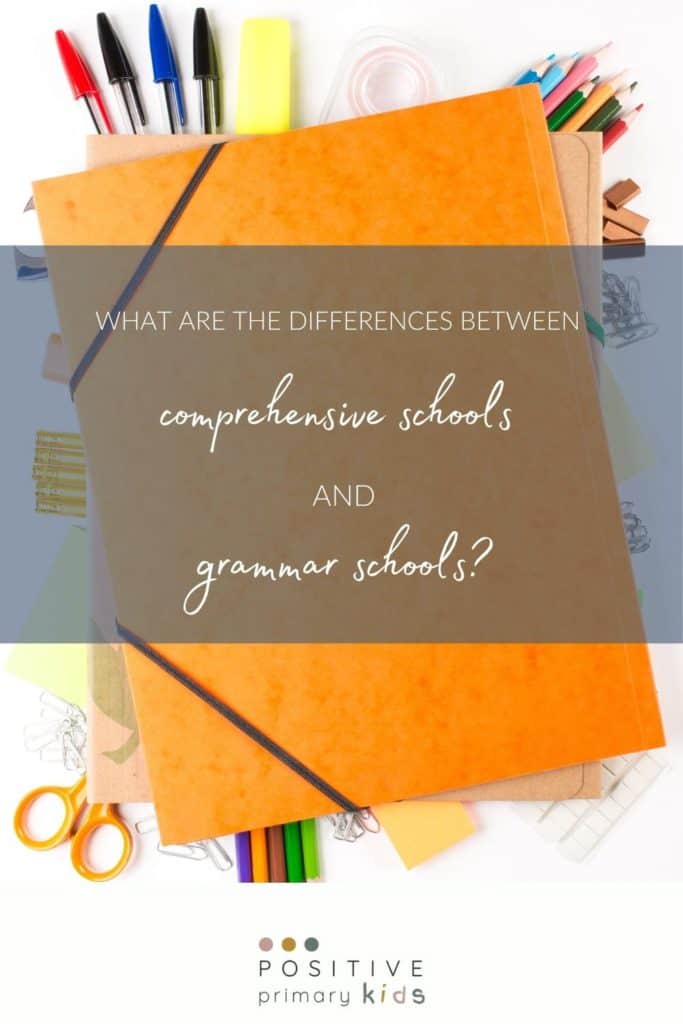For many parents, finding and choosing suitable secondary schools can be a bit of a daunting task. In this post, I’ll outline the main similarities and differences between comprehensive vs grammar schools to help you make the right choice for your child as an individual. If you didn’t catch my recent post on choosing the right secondary school, you might want to read that first.
Many of the children that I tutor each year are preparing for grammar school 11 plus exams. If your child is in year 4 or 5, this might be an option that you are starting to explore.
This post does not go into the advantages and disadvantages of each school type. My aim here is to simply help parents who are at the start of their search for secondary schools to compare both school types by presenting unbiased information.
In this post
-
What are comprehensive schools?
-
What are grammar schools?
-
What are the similarities between comprehensive and grammar schools?
-
What are the differences between comprehensive and grammar schools?
Affiliate Disclosure: This post may contain affiliate links. This means that I may receive a small commision – at no cost to you – if you make a purchase through these links. Thank you for your support!
What are Comprehensive Schools?
First introduced in the 1940s, comprehensive schools became more common from the mid-60s. Around 90% of secondary school children (aged 11-16) in the UK currently go to comprehensive schools.
Comprehensive schools are government-funded, provide free education to pupils of all abilities and follow the National Curriculum.
What are Grammar Schools?
Historically, grammar schools go back to the 16th century. Grammar schools as we know them today also started in the 1940s, when there were around 1,200 across the UK. There are now just 163 across England and only 5% of secondary school children attend them.
Grammar schools, like comprehensives, are also government funded and provide a free education. Hopeful pupils sit exams – known as ‘11 plus’ exams – which schools use to select those with the highest scores.
What are the similarities between comprehensive school and grammar school?
Comprehensive and grammar schools are both free to attend. However, grammar schools may offer more high-cost extra-curricular activities that could influence affordability. Both types of school are government-funded through local authorities, which pays for costs such as teacher salaries and premises costs.
All local authority funded schools are required to follow the National Curriculum unless there is a good reason not to.
Catchment areas can affect admissions to both comprehensive and grammar schools. Living within a school’s catchment area does not guarantee entry and many schools are oversubscribed. Grammar schools set their own entry criteria, and although they select pupils with the highest exam marks, sometimes places will be offered to children who live nearer but scored lower.

What are the main differences between comprehensive school and grammar school?
Original Purpose
The Education Act of 1944 (and the Education (Northern Ireland) Act 1947) created a nationwide system of free secondary education in England and Wales. It saw the establishment of three types of schools.
Grammar Schools were set up to propel the most academically able 25% of children towards university, whilst comprehensive schools provided education to those who there thought to be destined for trade jobs. The third type of school, ‘secondary technical schools’ never really took off.
Entry Requirements
The largest difference between these school types is that grammar schools select pupils based on ability. They are required to sit the ‘11 Plus’ exams, which usually take place during the September that they are in year 6. These exams test how academically-oriented pupils are and include a variety of subjects including Maths, English, Verbal Reasoning and Non-Verbal Reasoning. The 11 plus can be either multiple choice or standard format tests and grammar schools choose the subjects and format of the tests individually. Some grammar schools also test prospective pupils’ creative writing skills and require children to attend an interview. Demand for places is highly competitive, with ‘super selective’ grammar schools admitting only the highest scoring children. Preparing for the 11 plus can be quite a commitment, with many parents opting for professional tuition.
Comprehensive schools accept pupils of all abilities. Pupils are not required to sit exams to gain entry. Admission requirements vary and are usually set by the local authority. Criteria can include:
- The school’s catchment area
- If siblings already attend the school
- If children are entitled to pupil premium funding
- If they went to a particular ‘feeder’ school
- If they are, or have been, looked after or in care
Locations
Comprehensive schools are found throughout the entire UK. Grammar schools, however, are now only found in parts of England and Northern Ireland – 75% of local authorities have none. There are some counties of the UK that have a high proportion of grammar schools, such as Lincolnshire, which has 15.
Curriculum and Teaching
Teaching and learning expectations in grammar school tend to be more demanding and rigorous than comprehensives right from the start.
GCSEs might seem like a very distant concern, but it’s a good idea to get an idea of what your choice of secondary schools can offer and the results that they get.
The core curriculum of Maths, English and Science at GCSE is similar across grammar and comprehensive schools. Grammar schools may offer a greater range of academic and specialist subjects, such as Politics, Classical Civilisations Biology, Chemistry and Physics as individual sciences. Some comprehensive schools may not offer as many options at this level.
GCSE Attainment
Generally, grammar schools achieve higher GCSE exam results than non-selective comprehensive schools.
Government Data compared the percentage of pupils achieving grades 9-5 (approximately A-C in old grades) in English and maths GCSE in 2019. Results showed 92.9% of pupils achieving 9-5 passes at grammar schools and 44.1% achieving the same level at non-selective comprehensive schools.
Summary
I hope that this has helped to get you started if you are a parent who is beginning to think about which type of secondary school will be suitable for your child.
In summary, the main difference between comprehensive and grammar schools is that grammars select pupils based on their ability. Comprehensive schools are a great option for most children. Academically motivated children might benefit from the more rigorous and focussed approach to education offered by grammar schools.
If you would like to learn more about grammar school 11 Plus exams keep an eye out for next week’s post. I will be explaining the subjects that are tested and discussing how you can prepare your child for the exams.
Any questions or comments? Let me know in the comments section below.
Considering 11 Plus Prep? I can help!
Preparing for entrance exams is often overwhelming. I specialise in providing a tailored approach to tutoring that prepares children for grammar school 11 plus tests. Covering Maths, English, Verbal Reasoning and Non-Verbal Reasonal for GL Assessment exams, lessons are engaging, effective and multisensory.
Please get in touch if you’d like to discuss your child’s needs. You can book a free and friendly consultation at a time to suit you by clicking the button below.
- Grammar School Statistics Briefing Paper – House of Commons Library
- Schools, pupils and their characteristics – The United Kingdom Statistics Authority







0 Comments